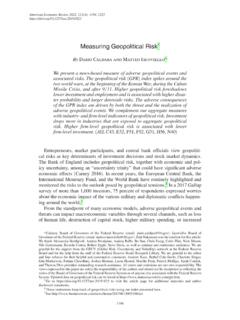Transcription of NATIONAL BUREAU OF ECONOMIC RESEARCH
1 NBER WORKING PAPER SERIES. CENTRAL BANK DIGITAL CURRENCY. AND THE FUTURE OF MONETARY POLICY. Michael D Bordo Andrew T Levin Working Paper 23711. NATIONAL BUREAU OF ECONOMIC RESEARCH . 1050 Massachusetts Avenue Cambridge, MA 02138. August 2017. Bordo is a professor of economics at Rutgers University, director of the Center for Monetary and Financial History, a RESEARCH associate of the NATIONAL BUREAU of ECONOMIC RESEARCH (NBER), and a Distinguished Visiting Fellow at the Hoover Institution, Stanford University. Levin is a professor of economics at Dartmouth College, visiting scholar at the International Monetary Fund and at the Bank of Canada, external advisor to the Bank of Korea, RESEARCH associate of the NBER, and international RESEARCH fellow of the Centre for ECONOMIC Policy RESEARCH (CEPR). This paper is dedicated to the memory of Allan Meltzer. We appreciate many invaluable conversations with Christopher Erceg, Oyvind Eitrheim, Peter Fisher, Marvin Goodfriend, and John Taylor, as well as helpful comments received from participants in workshops and conferences hosted by the Hoover Institution, Cato Institute, Fondo Latinoamericano de Reservas (FLAR), Bank of Canada, Banque de France, Norges Bank, Sveriges Riksbank, and the Swiss NATIONAL Bank.
2 Nonetheless, the views expressed here are solely those of the authors and do not represent the views of any other person or institution, nor those of the NATIONAL BUREAU of ECONOMIC RESEARCH . NBER working papers are circulated for discussion and comment purposes. They have not been peer-reviewed or been subject to the review by the NBER Board of Directors that accompanies official NBER publications. 2017 by Michael D Bordo and Andrew T Levin. All rights reserved. Short sections of text, not to exceed two paragraphs, may be quoted without explicit permission provided that full credit, including notice, is given to the source. Central Bank Digital Currency and the Future of Monetary Policy Michael D Bordo and Andrew T Levin NBER Working Paper No. 23711. August 2017. JEL No. B12,B13,B22,E42,E52,E58,E63. ABSTRACT. We consider how a central bank digital currency (CBDC) could transform all aspects of the monetary system and facilitate the systematic and transparent conduct of monetary policy.
3 In particular, we find that CBDC can serve as a practically costless medium of exchange, secure store of value, and stable unit of account. To achieve these criteria, CBDC would be account- based and interest-bearing, and the monetary policy framework would foster true price stability. Michael D Bordo Department of Economics Rutgers University New Jersey Hall 75 Hamilton Street New Brunswick, NJ 08901. and NBER. Andrew T Levin Department of Economics Dartmouth College 6106 Rockefeller Hall Hanover, NH 03755. and NBER. 1. Introduction For there was once a time when no such thing as money material was selected which, being given a stable value by the state, avoided the problems of barter by providing a constant medium of exchange. That material, struck in due form by the mint, demonstrates its utility and title not by its substance as such but by its quantity, so that no longer are the things exchanged both called wares but one of them is termed the price.
4 And today it is a matter for doubt whether one can talk of sale when no money Julius Paulus Prudentissimus, circa 230 In ancient Rome, the emperor's chief legal advisor described the fundamental rationale for a government-issued currency using terms that remain familiar to modern monetary economists: (i) a unit of account for the pricing of goods and services; (ii) a method of storing value; and (iii) a medium of exchange that facilitates ECONOMIC and financial transactions. Moreover, the Roman jurist recognized that the utility of currency depends not on its material substance but on its nominal quantity; that is, the efficacy of the currency hinges on public confidence in the authorities' management of the monetary Nearly two millenia later, as electronic devices and high-speed networks have become practically ubiquitous, central banks around the globe are now actively exploring the possibility of establishing sovereign digital Just like paper currency and coins, central bank digital currency (CBDC) would be fixed in nominal terms, universally accessible, and valid as legal tender for all public and private transactions.
5 Consequently, CBDC is essentially different from the various forms of virtual currency (such as bitcoin, ethereum, and ripple) that have been created by private entities and whose market prices have exhibited very sharp fluctuations in recent 1. Paulus served as chief legal advisor to the Roman emperor Severus Alexander (222-235 ), during a period of multiple revisions to the designated purity and weight in silver of the Roman denarius. He was granted the honorific prudentissimus and his commentaries were later included in the Digest, a legal compendium produced by the Byzantine emperor Justinian. The excerpt shown here is taken from section of the Digest;. the translation from the original Latin is that of Watson (2010), 2. Schumpeter (1954, ) interpreted Paulus' text as indicating that people, in handling money in everyday transactions, usually take a coin at its nominal value without any conscious thought of the commodity value of its materials.
6 3. For example, the Sveriges Riksbank has an accelerated timeframe for deciding whether to launch a CBDC. (Boel 2016 and Skingsley 2016), the People's Bank of China is experimenting with technical specifications (Fan 2016), and the Bank of England is conducting a multiyear investigation (Broadbent 2016). See also recent perspectives from officials at the European Central Bank (Mersch 2017) and Norges Bank (Nicolaisen 2017). 4. See McCallum (2015) and Weber (2016). As of July 2017, the market capitalizations for bitcoin, ethereum, and ripple were about $42 billion, $25 billion, and $9 billion, respectively, and the year-to-date changes in their unit prices were roughly 250 percent, 3000 percent, and 4000 percent, respectively ( ). 2. In this paper, we analyze the key features of CBDC, focusing on basic design characteristics rather than technical details. In particular, we consider the following issues: (1) Should CBDC payments involve transfers between accounts held at the central bank, or digital tokens that can be transferred directly from payer to payee?
7 (2) Should cash be abolished, or should the central bank establish a schedule of fees for transferring funds between CBDC. and paper currency? (3) Should CBDC be interest-bearing or indexed to an aggregate price index rather than having a constant nominal value like cash and coins? (4) What are the implications of CBDC for the central bank's monetary policy strategy and operating procedures? (5) How will CBDC affect the interactions between the central bank and the fiscal authorities? In considering these issues, we assume that the central bank's objective is to maximize the effectiveness of CBDC in fulfilling the basic functions of any public currency, namely, its efficiency as a medium of exchange, its security as a store of value, and its stability as the unit of account for ECONOMIC and financial transactions. Using those criteria, we identify the following characteristics of a well-designed CBDC: An account-based CBDC could serve as a practically costless medium of exchange.
8 Such accounts could be held directly at the central bank itself or made available via public-private partnerships with commercial banks. An interest-bearing CBDC could provide a secure store of value, with a rate of return in line with other risk-free assets such as short-term government securities. The CBDC interest rate could serve as the main tool for conducting monetary policy. To facilitate the gradual obsolescence of paper currency, CBDC could be made widely available to the public, with a graduated schedule of fees on transfers between cash and CBDC. Consequently, adjustments to the CBDC interest rate would not be constrained by any effective lower bound. The monetary policy framework could foster true price stability, that is, the real value of CBDC would remain stable over time in terms of a broad consumer price index. Such a framework would facilitate the systematic and transparent conduct of monetary policy.
9 This analysis draws on a very long strand of literature in monetary economics. The quest for a stable unit of account was pursued by luminaries like Jevons (1875), Marshall (1877), 3. Wicksell (1898), Fisher (1913), Buchanan (1962), and Hayek (1978).5 The rationale for an efficient medium of exchange was highlighted by Friedman (1960), who argued that government-issued money should bear the same rate of return as other risk-free assets. These two goals that is, a stable unit of account and an efficient medium of exchange . seemed to be irreconcilable due to the impracticalities of paying interest on paper currency, and hence Friedman advocated a steady deflation rather than price stability. But the achievement of both goals has now become feasible via a well-designed As a practically costless medium of exchange, CBDC would significantly enhance the efficiency of the payments system.
10 For example, a recent IMF study has pointed out that the introduction of CBDC would facilitate more rapid and secure settlement of cross-border financial CBDC would be particularly beneficial for lower-income households, who tend to rely heavily on cash, and for small businesses, which incur substantial costs for handling cash or substantial interchange fees for taking payments via debit and credit cards. At a macroeconomic level, researchers at the Bank of England have estimated that the productivity gains from adopting CBDC would be similar to those of a substantial reduction in distortionary The interest-bearing design of CBDC and the obsolescence of paper currency would also contribute to greater macroeconomic stability, because interest rate adjustments would no longer be constrained by any effective lower bound in response to severe adverse That lower bound has been a key reason why many central banks currently aim at positive inflation rates of 2 percent or more, whereas CBDC will essentially eliminate the need to maintain such an inflation buffer or to deploy alternative monetary policy tools such as quantitative easing or credit subsidies.













